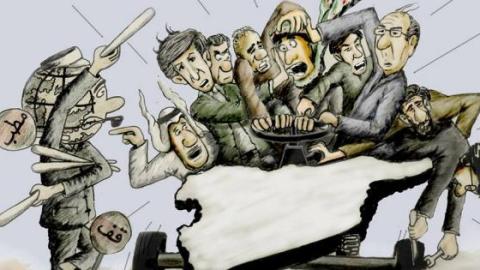The painter of Horan crosses several streets and neighborhoods, defying security checkpoints and snipers on the roofs of government buildings while he carries his sarcastic drawings on his mobile phone or flash drive. He risks his life to reach one of the secrecy houses in Daraa, where there is internet connection, to upload his drawings on a page named "The Rebel Painter of Horan".
Through these prints, he is trying to deliver the voice of Daraa, the cradle of the revolution, further than what has been covered by media stream since arms deployed into the conflict. There is life in this city, whose school children wrote the first revolution slogans, beyond the armed struggles. There is also hope for a future free of violence, while colors shine behind the tanks, lovers kiss under the voice of the mortar, and a painter brush catches these instants of a people "climbing to reach their own freedom", e mocking the dictatorship, the dead world, the dullness of politicians and thopposition`s laziness.
Friends of the "Rebel Painter of Horan" created the page to share his talented work, which represents the voices of the people. He works under very compelling circumstances to present an art that is “dipped in blood", in his own words. Backouts, bombing, destruction and lack of resources due to city isolation are the daily obstacles he faces. Despite all, the attempts to silence activists´ voices did not succeed. As the situation is getting worse since (shelling, snipers, streets, raids, battles), which result in electricity and internet outages, activists come up with other resrouces, such as using the Jordanian network.
The young artist draws with simple tools: pencil, ink and colors; and shares his work through his mobile phone.
How did his relationship with the revolution start?
Since the first day, I participated in front of the Omari mosque, where I was waiting for this day like others. My first contribution, in addition to attendingt he protests, was to write banners with three other people. Those were distributed by a security wanted fellow. We faced difficulties as security raids on homes increased, we had to change the workplace from one place to another, and erase any trace of our paint, pens, papers, and textiles by hiding the materials in the valley near or among the trees or in holes on the ground.
Based on the irony of regime`s characters, he draws the head of state, his followers, ministers and clerics men cartoons, adding comments and justifications from those in the defense of the authority.

In one of his drawings he mocked the political solution proposed by the regime, through a carpet with a Scud missile hidden under it: "Strange..?! Those who see a political solution and not see Scud missiles", was his description. He has repeatedly mocked the silence and passivity of the international community, especially the position of UN envoy to Syria Lakhdar Brahimi, the Russian government and all political debates which the dictatorship profits from.
The "Rebel Painter of Horan" represents an achievement of a revolution that gives birth to beauty from the womb of violence. Since the beginning of the uprising against tyranny, Syrians started to produce what was forbidden for decades, and these paintings exemplify to what extent the wall of silence has been broken for the sake of free expression.
The painter, who believes in a peaceful solution, organizes demonstrations between bombings, raids and battles. He explains:
"I presented a few drawings in the demonstrations, but the shelling vetoed me to draw more. People begun to be displaced while regime tanks invaded the towns and the fighting erupted between the regime and the free army. Nevertheless, there remains a small space for demonstrations".
He concludes:
The uprising did not tend to violence, violence was ignited by the regime, which repressed any space for peaceful and civil demonstrations. We already took to the streets once and we will be ready to do it again, any time, despite any attempts by the regime or foreign powers to deprive us from our civil movement.
See all the drawings by the "Rebel Painter of Horan" on his Facebook page.
Translated by Rami Alhames



